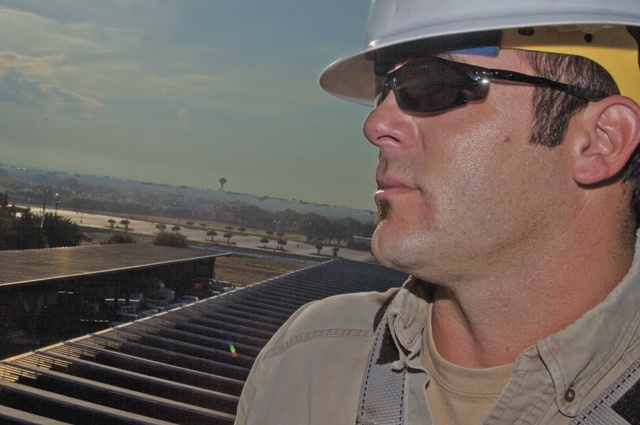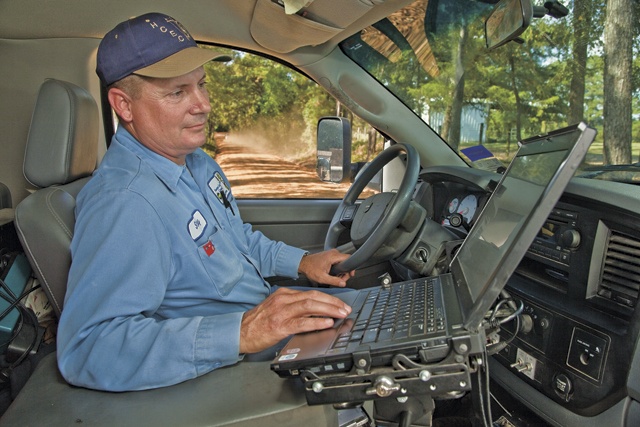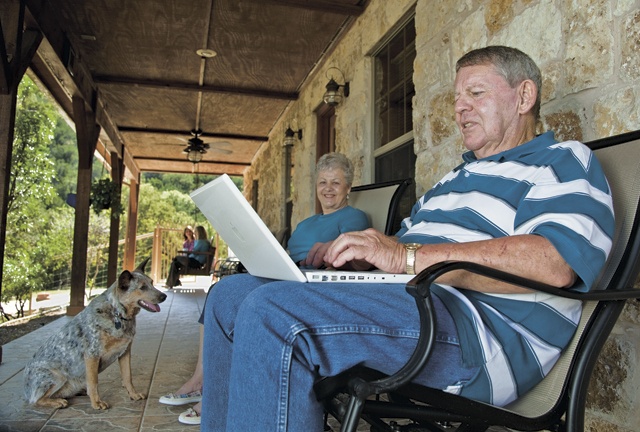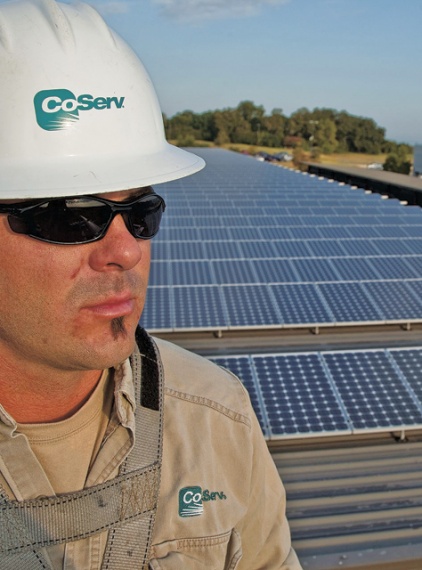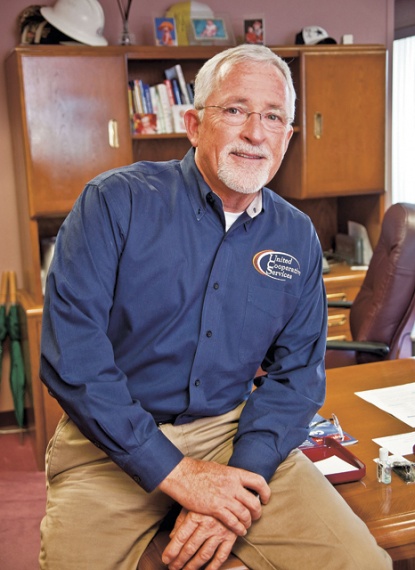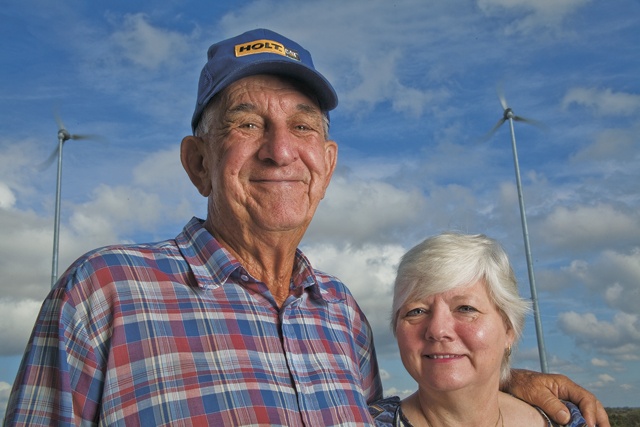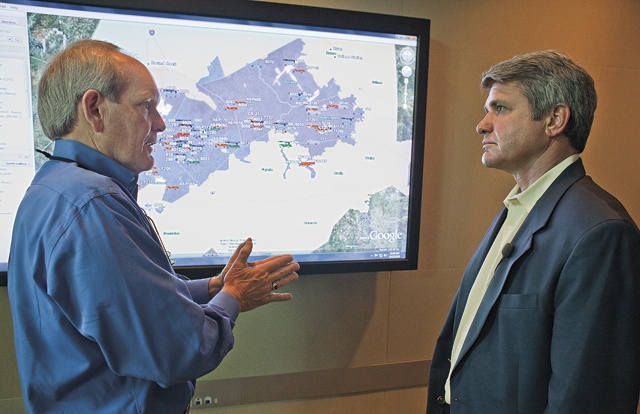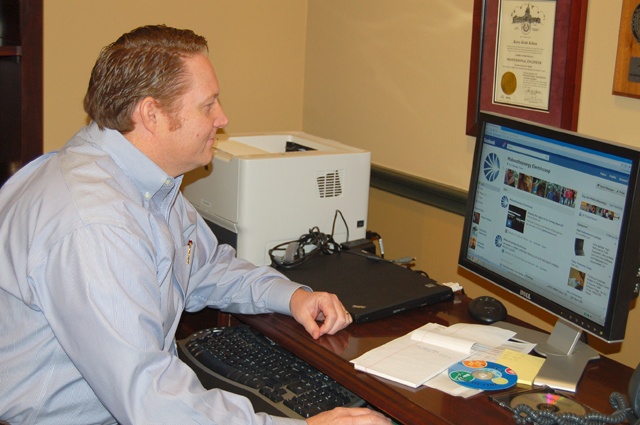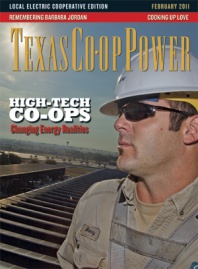As an electric cooperative member, you have a stake in the future of electricity availability, reliability and cost—all of which the new smart grid technologies are intended to manage. To be most effective, these new technologies also give you the tools to monitor and control your own energy use.
With that in mind, envision the smart grid as many systems talking back and forth, each component playing a role in getting electricity from the source of generation, through hundreds of miles of transmission lines, to your co-op’s distribution lines to your coffeemaker, as efficiently as possible.
From their inception in the 1930s, electric cooperatives have been problem solvers. The problems of the 21st century require action that will assure all of us have the electricity we need in the future. In this story, we’ll show you how some co-ops in Texas are meeting the challenge.
Texas Helping Lead the Way
Today, according to the Federal Energy Regulatory Commission, electric co-ops across the country lead the industry in the deployment of smart meter infrastructure with an advanced metering penetration of 16.4 percent in 2008—well above the industry as a whole. The National Rural Electric Cooperative Association estimates that about half of the nation’s more than 900 electric co-ops have implemented advanced technologies of some fashion. Here in Texas, generation and transmission and distribution cooperatives from the Panhandle to the Piney Woods have deployed “smart” technologies such as advanced metering infrastructure (AMI) and online energy-monitoring programs for members.
In this story, we’ve taken a sampling of co-ops in Texas to highlight some of the smart grid technology and educational efforts that are duplicated at co-ops throughout the state.
‘Like Stepping Out of the Dinosaur Age’
In the dense woodlands of East Texas, just a pinecone’s throw from the Davy Crockett National Forest, Houston County Electric Cooperative was a pioneer in deploying smart meters to its 15,000 members. In 2004, before the idea of a smart grid was popularized, the Crockett-based co-op recognized that meters with two-way communication capabilities could significantly improve efficiencies and reliability.
With an average of slightly more than four meters per mile and 4,800 miles of line, Houston County’s service area is too spread out to make regular meter reading by employees economical. Instead, members used to report their own meter readings, with periodic follow-up checks by contract workers. Now that the smart meters send usage data directly to the co-op, revenue losses from inaccurate readings and instances of electricity theft have been virtually eliminated.
In a part of the state often hit hard by hurricanes, an even more important advantage of AMI is realized during massive weather-related outages. Prior to the days of AMI, members had to call in their outages to be tracked by the co-op and added to a list for power restoration. But likely as not, the phone lines went down along with the utility poles. With no phone service, members still without lights after power was restored in some segments had no way of notifying the co-op. The service trucks would have already pulled out, with officials thinking everyone was back up.
When Hurricane Ike snuffed out power throughout large areas of East Texas in 2008, the co-op’s smart meters provided accurate information on widespread outages as well as individual power losses. Service trucks equipped with vehicle location devices showed up on digital maps at the co-op’s headquarters. Outages detected by the meters likewise were pinpointed on service area maps.
Carleen Brister, a dispatcher who has been with Houston County EC more than 12 years, says smart meters made all the difference in managing the aftermath of the hurricane. Much of the overwhelming work involved in restoring power—from tree removal to energizing substations and transformers, to bringing power back to members—could be directed and monitored from Brister’s desk. “When AMI came, it was like stepping out of the dinosaur age,” she says.
As more improvements are added to the “smart” system, even greater efficiencies will be realized, says General Manager Melody Pinnell. Her plans for the future include researching technology for digitally controlling system inventory. But, she says, “Before we adopt any technology, we look at how it will make us more efficient and benefit our members.”
Advanced Technology Gatekeepers
Bandera Electric Cooperative, headquartered in Bandera, has just completed a systemwide deployment of smart meters, or AMI, a sophisticated two-way communication technology in which the co-op and members’ meters can exchange information. One system made possible by this is a Web portal called “smartWatch,” which was first tested with the co-op’s Member Advocacy Committee. Dick Earnest is one of about a dozen Bandera EC members who serve on the committee. You might call them the gatekeepers who find out how the new technology works for real people before it gets approved by the board for the rest of the co-op’s nearly 30,000 members.
From the front porch of his Hill Country home near Concan, Earnest can play with his dog, Ginger, visit with neighbors and his wife, Jerilyn, and use his laptop to log on to the co-op’s smartWatch site, where he checks his energy consumption during the preceding days, weeks or months. Earnest, a congenial retired marketing manager from an investor-owned utility, admits he is somewhat of an energy-consumption nerd. In fact, he installed his own meter to monitor monthly electricity use by his water heater.
“Years ago, it was just a dream that utilities would do something on the customer side for controlling and evaluating usage and cost,” he says. These days, it’s a reality.
Earnest will soon have more control over his energy cost with Bandera EC’s time-of-use rate structure set to be implemented in late 2011. With time-of-use rates, electricity used during the peak hours costs more than that used very late at night through the wee hours of the morning. This type of rate structure is possible only when the co-op and member can see usage in 15-minute intervals, one function of smart meters.
With Bandera EC’s recently completed, totally digitized system control center, vital data appear on one of six monitors at the click of a mouse. System operators Erlinda Escamilla-Pina and Cheri Smith can “ping” a meter and receive immediate data on energy use. From their desks, they can determine whether there is an outage before they send a crew out in the field. If it’s a transformer problem, they go to the service truck locater map and dispatch the closest lineman. Each of these functions saves money and time—both the co-op’s and the member’s.
Member education is a vital factor in Bandera EC’s formula for sustainability in a rapidly changing industry. Anticipating a future in which increasing numbers of members will want to produce at least some of their own electricity, the co-op has installed a solar, or photovoltaic (PV), panel in front of its Bandera office so members can see a renewable system in action. Members can view the system’s production in real time in the lobby, along with the cost, to give them the tools necessary for making informed decisions.
Members Take Control of Energy Use Reduction
Just north of Dallas, Corinth-based CoServ Electric serves more than 130,000 members across a diverse area of ranches, farmland and suburbs. In 2009, the co-op applied for, and received, a $17.2 million U.S. Department of Energy grant to support deployment of advanced metering and electric distribution technologies.
To get the most out of the new, sophisticated operating and monitoring systems, the co-op has engaged in a robust educational effort for employees and members. A series of demonstrations and exhibits teaches about the information gathering and sharing capabilities of “eCoGrid,” the co-op’s brand name for the advanced meter network.
With all that information zipping around in cyberspace, some have raised security and privacy concerns. Stacia Sims, CoServ’s senior vice president of information services, reassures members that the system is safe.
“Using various encryption and authentication methods similar to those used in the banking industry, CoServ’s eCoGrid is designed to help prevent system identity theft, such as drive-by hacker attempts,” Sims explains. “Should someone intercept meter data without the unique ‘key’ held only by CoServ, the data is simply a scrambled mess. Should someone try to inject information into the data stream, the system will recognize that it is not from an authorized source, not accept the information into the system, and alert CoServ of the situation.”
Increasing numbers of CoServ members are investigating individual measures for offsetting energy costs, such as installing PV panels. To encourage members’ use of renewables, the co-op offers rebates and, last year, installed a 95-kilowatt array of its own solar panels to better inform members about the efficacy of investing in PV.
“We want more hands-on experience with solar so we can gather the data ourselves and help members make good investment decisions,” says Shane Laws, director of retail programs. The co-op’s solar installation provides about 130,000 kilowatt-hours (kWh) of energy annually to supply a portion of the headquarters building’s electricity needs.
Already, 49 members who generate their own power and are properly interconnected with CoServ’s system are realizing savings for the amount of electricity they produce—a practice called “net metering.”
Curtis Trivitt, CoServ’s senior vice president of energy services, says, “Historically, cooperatives have been innovators in using technology to help members. What we’re doing is not new, but the capabilities have advanced.”
He adds, “When we look at investing in technology, we ask the question: How does this benefit the member? CoServ recognizes its responsibility to partner with members in reducing costs through using technology that puts them in control of reducing their usage.”
Giving Members Energy Efficiency Tools—and Answers
Ray Beavers saw it coming. Even before he became CEO/general manager of United Cooperative Services (UCS), he was paying attention to signals that portended major shifts in the utility industry. “In 2003 and 2004, when power costs started going up, I thought, ‘this is not just an aberration.’ The more we looked at it, the more we knew we were in for future increases. After a long period of rate stability, how would members react to increasing costs?”
Today, Beavers is nationally recognized as a co-op leader in energy efficiency education and a thoughtful analyst of the benefits of new technology.
Last fall, UCS, headquartered in Cleburne, was one of nine entities nationwide selected by the U.S. Department of Energy to participate in an energy efficiency pilot, the Home Energy Score program, to measure the effectiveness of certain energy-efficiency practices.
“Members expect the co-op to be the problem solver,” Beavers explains. “That’s how co-ops were born, and we are morally responsible for giving our members answers.”
Before launching their comprehensive energy conservation program, for example, members of the UCS team tried to put themselves inside their 54,000 members’ heads: Where are they? How can we prepare them for inevitable cost increases? What can we do?
The answers provided the design for the co-op’s rebate program, free energy audits, extensive education efforts and consumer grants to help pay for qualifying upgrades, such as new insulation, solar screens, skirting and ductwork repair. Marty Haught, vice president, Communications, says UCS, along with its power provider, Brazos Electric Power Cooperative, invested close to $500,000 in member-directed energy efficiency efforts during 2010, including 1,500 energy audits.
Energy innovation, Beavers says, will bridge the old supply-side dynamic to a new demand-side model encompassing energy conservation, distributed generation, energy efficiency and demand response. “Our industry has been dictated by a supply-side perspective,” he says. “Now, the focus is on transitioning to the demand side, where consumers and members have more control in how they use electricity.”
What about the role of technology and the promise of a smart grid? UCS already has smart meters in place systemwide and has had them for seven years. The co-op will continue to implement technological advances as appropriate, but Beavers cautions: “Technology can’t fix inefficiencies in conservation behavior. That takes a lot of communication, working first on awareness, education, practice and behavioral changes. When that happens, technology will be useful. We’re driven to do what’s in the best interest of our members, and we know what the future holds.”
Turbines Part of Energy Reduction Package
Walter and Brenda Engelmann enjoy sitting on the back porch of their hilltop home outside Seguin watching their two wind turbines make electricity. They delight in these 2.4-kilowatt turbines as if they were children whose every action elicits joy. “Listen,” says Brenda. “You can hear the whine change pitches as the wind picks up speed.” And you can see each turbine head turn slowly into the wind, tracking its course like a weather vane. Yes, it’s mesmerizing.
But more important to the Engelmanns—who purchased the turbines from their co-op, Guadalupe Valley Electric Cooperative (GVEC) in Gonzales—they are producing their own electricity from a renewable energy source. “We felt very strongly that we wanted to do something to reduce our [Americans’] dependence on fossil fuels,” says Brenda. “It’s just the right thing to do. I wish more people would do it.”
Each turbine is connected to a meter that reads the amount of electricity generated. If that amount ever exceeded the Engelmanns’ total usage, they would get credit based on wholesale cost from the co-op. On average, together the turbines produce 250 kWh a month. The average home uses between 1,000 and 1,500 kWh a month, but the Engelmanns have reduced their total monthly consumption to around 600 kWh by observing energy efficient practices in everything from the way their home was built to drying laundry outdoors.
“Our members were calling and asking for information about wind turbines,” says General Manager/CEO Darren Schauer. “In order to educate them, we had to educate ourselves, so we decided to find what we believed was the best turbine on the market, train our service team to install and maintain them, and offer members a product they could trust.”
The co-op is also investigating solar technology, with plans to sell and service PV systems if it finds a model that delivers up to its expectations.
GVEC has been aggressive in promoting energy efficiency practices among its nearly 66,000 members. In 2010, the co-op gave out more than $1 million in rebates for energy efficient upgrades, appliances and the installation of renewable energy sources.
Empowering Members to Make Wise Energy Decisions
Bluebonnet Electric Cooperative has positioned itself as a leader in moving toward a smart grid and, beyond that, to what General Manager/CEO Mark Rose calls a “sustainable” grid—one that neutralizes, and perhaps even reduces, the co-op system’s impact on the overall state grid.
“In June 2010, we introduced the Net Energy Market, our consumer Web portal, where our members can access the same information about their energy use we have in our control center and our billing system,” Rose says. “This empowers our members to make informed decisions about when and how to use electricity. No longer will our members be surprised by a high electric bill they didn’t know was coming.”
In December, the co-op began a yearlong pilot project in partnership with Consert, Inc., and the Lower Colorado River Authority. The pilot uses Consert’s demand-management solution and equipment, which includes a programmable thermostat and energy-control devices on electric water heaters and pool pumps. Bluebonnet EC’s members set up their home energy profiles and have the ability to change their settings from any computer with Internet access. During periods of high energy demand, the co-op can reduce demand on its system by controlling its members’ consumption based on their energy profiles.
This past fall, U.S. Reps. Michael McCaul (R-Austin) and Lloyd Doggett (D-Austin) visited Bluebonnet’s headquarters in Bastrop and saw firsthand how smart grid technology benefits their constituents—who are the cooperative’s members—and the utility.
“I was very impressed with Bluebonnet’s facility, which is in the heart of my district,” McCaul said. “It has one of the most advanced distribution systems with smart grid technology in the nation in terms of saving money, increasing energy efficiency and creating a positive impact on the environment.”
“Responsive consumer service and cutting-edge demand-management technology is the very type of innovation all of America needs,” Doggett said. “Bluebonnet is leading the way by recognizing the value of co-op members using as little electricity as possible to satisfy their individual needs. The smart grid will empower each member with timely information to enable an informed decision about energy use.”
Bluebonnet EC’s Sustainable Grid initiative incorporates smart grid technology and regional economic development activities to encourage environmentally responsible commercial and residential developments and job growth.
Social Networking: All Information, All the Time
Geographically, Mid-South Synergy is located in Navasota, southeast of Texas A&M University in College Station. But you’d be wrong if you thought that was the only place to find the electric co-op. Look on Facebook. Subscribe to Twitter. Find it on YouTube. Go to its website and see just how much space the co-op is occupying beyond the borders of its service area.
When it comes to social networking, Mid-South Synergy has jumped in with both feet. General Manager Kerry Kelton recognizes social networking’s potential for keeping members informed and connected with the co-op.
Want to learn the history of Mid-South Synergy? Go to www.youtube.com/user/midsouthsynergy.
Looking for updates on an outage? Go to www.twitter.com/midsouthsynergy.
Needing some ideas on how to lower your energy costs? Go to www.facebook.com/MidSouthSynergyCoop.
“There was a time when we could go to the local café or feed store and find out what our members were thinking,” Kelton says. “Times have changed, and so have our members. But we still want to know what they are thinking, and by using the tools of social media we can listen to what they are saying and share ways to help meet their needs.”
Social media is not simply another advertising channel for Mid-South. Members ask questions, comment on issues, and encourage the work of the cooperative. The various social media channels are monitored so comments can be acknowledged and questions answered.
“Using social media to encourage member participation helps Mid-South Synergy to be committed not just to great service, but to the people we serve,” Kelton says.
——————–
Carol Moczygemba is executive editor of Texas Co-op Power.
